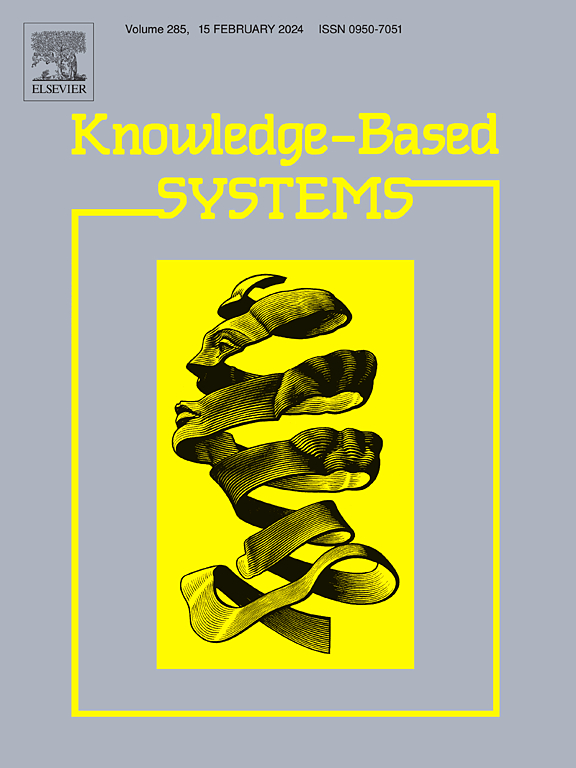你只需要雾霾:双向解缠翻译网络无监督图像去雾
IF 7.6
1区 计算机科学
Q1 COMPUTER SCIENCE, ARTIFICIAL INTELLIGENCE
引用次数: 0
摘要
近年来,基于学习的方法通过对合成配对数据集进行监督训练,在图像去雾方面取得了显著进展。然而,合成图像和真实世界模糊图像之间的巨大领域差距往往会损害泛化性能,从而限制了它们在实际应用中的有效性,因为目标领域与训练数据存在显著差异。更糟糕的是,在现实场景中获取足够的像素对齐模糊清晰的图像对既昂贵又具有挑战性。为此,我们引入了一种新型的双向解纠缠翻译网络(BDT-Net)用于无监督除雾,该网络将雾霾去除视为一种特征解纠缠任务,即从清洁因子中分离出内容相关信息,从模糊因子中分离出雾霾相关信息。具体来说,我们设计了一个双分支解纠缠框架,包括用于提取结构内容信息的内容恢复分支(CRB)和用于捕获雾霾相关特征的参数估计分支(PEB)。其中,我们利用基于物理的正向除雾和反向复原模型来建立雾霾周期一致性,因此我们的BDT-Net只需要雾霾图像本身就可以进行优化。为了更好地区分潜在空间中的雾霾信息和干净内容,我们设计了一种有效的特征对比表示(FCR),该方法不仅可以考虑每个信息流内部固有的自相似性,还可以利用不同组件之间的互斥性。此外,双向像素对比表示(PCR)被纳入,以提高恢复清晰的图像清晰度和内容的能力。在基准数据集上的大量实验结果表明,我们的BDT-Net优于其他比较先进的方法。本文章由计算机程序翻译,如有差异,请以英文原文为准。
You only need haze: Bidirectional disentangled translation network for unsupervised image dehazing
Recently, learning-based methods have achieved notable progress in image dehazing through supervised training on synthetically paired datasets. However, the substantial domain gap between synthetic and real-world hazy images often impairs generalization performance, thereby limiting their effectiveness in practical applications where target domains differ significantly from the training data. Even worse, acquiring sufficient pixel-aligned hazy-clear image pairs in real-world scenarios is costly and challenging. To this end, we introduce a novel Bidirectional Disentangled Translation Network (BDT-Net) for unsupervised dehazing, which regards haze removal as a feature disentanglement task, i.e., separating content-relevant information from the clean factor and haze-related information from the fuzzy factor. Specifically, we design a dual-branch disentanglement framework comprising a Content Recovery Branch (CRB) for extracting structural content information and a Parameter Estimation Branch (PEB) dedicated to capturing haze-related characteristics. Among them, we leverage forward dehazing and reverse rehazing physics-based models to establish haze cycle consistency, thus our BDT-Net can be optimized only needing the hazy image itself. To better distinguish the haze information from the clean content in the latent space, we design an effective Feature-wise Contrastive Representation (FCR), which can not only consider the inherent self-similarity within each information flow but also exploit the mutual exclusivity between different components. Furthermore, a two-way Pixel-wise Contrastive Representation (PCR) is incorporated to enhance the capability of restoring clear image clarity and content. Extensive experimental results on benchmark datasets demonstrate the superiority of our BDT-Net over other compared state-of-the-art methods.
求助全文
通过发布文献求助,成功后即可免费获取论文全文。
去求助
来源期刊

Knowledge-Based Systems
工程技术-计算机:人工智能
CiteScore
14.80
自引率
12.50%
发文量
1245
审稿时长
7.8 months
期刊介绍:
Knowledge-Based Systems, an international and interdisciplinary journal in artificial intelligence, publishes original, innovative, and creative research results in the field. It focuses on knowledge-based and other artificial intelligence techniques-based systems. The journal aims to support human prediction and decision-making through data science and computation techniques, provide a balanced coverage of theory and practical study, and encourage the development and implementation of knowledge-based intelligence models, methods, systems, and software tools. Applications in business, government, education, engineering, and healthcare are emphasized.
 求助内容:
求助内容: 应助结果提醒方式:
应助结果提醒方式:


